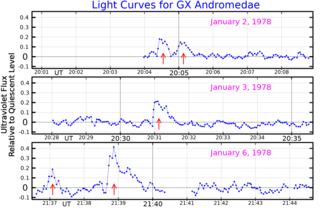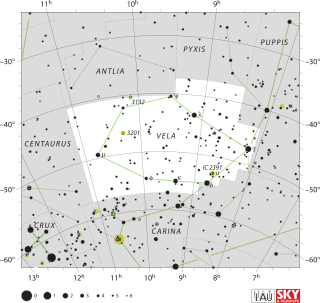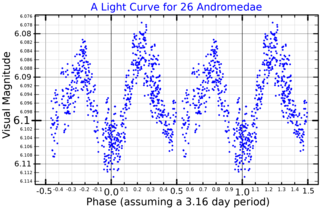Related Research Articles
Xi Boötis, Latinised from ξ Boötis, is a binary star system located at a distance of 22 light-years away from Earth. It is the nearest visible star in the constellation Boötes. The brighter, primary component of the pair has a visual magnitude of 4.70, making it visible to the naked eye.

Groombridge 34 is a binary star system in the northern constellation of Andromeda. It was listed as entry number 34 in A Catalogue of Circumpolar Stars, published posthumously in 1838 by British astronomer Stephen Groombridge. Based upon parallax measurements taken by the Gaia spacecraft, the system is located about 11.6 light-years from the Sun. This positions the pair among the nearest stars to the Solar System.

Psi Velorum, Latinized from ψ Velorum, is a binary star system in the southern constellation of Vela. Based upon an annual parallax shift of 53.15 mas as seen from Earth, it is located 61.4 light years from the Sun. It is visible to the naked eye with a combined apparent visual magnitude of +3.58. The motion of this system through space makes it a candidate member of the Castor stellar kinematic group.

Lambda Andromedae, Latinized from λ Andromedae, is the Bayer designation for a binary star system in the northern constellation of Andromeda. At an estimated distance of approximately 84.6 light-years from Earth, it has an apparent visual magnitude of +3.8. This is bright enough to be seen with the naked eye. The system is drifting further away from the Sun with a radial velocity of +6.8 km/s.
47 Andromedae is a binary star system in the northern constellation of Andromeda. The designation is from the star catalogue of John Flamsteed, first published in 1712. The system has a combined apparent visual magnitude of 5.60, which is just bright enough to be faintly visible to the naked eye under good seeing conditions. The distance to this system, as determined from an annual parallax shift of 15.9805 mas, is about 204 light years. It is moving away from the Sun with a heliocentric radial velocity of +13.3 km/s.
12 Andromedae is a single star in the northern constellation of Andromeda. The designation is from the star catalogue of English astronomer John Flamsteed, first published in 1712. It has an apparent visual magnitude of 5.87, which indicates it is just visible to the naked eye under good seeing conditions. An annual parallax shift of 23.7806 mas provides a distance estimate of 137 light years. The star is moving closer to the Sun with a radial velocity of −10.5 km/s.

26 Andromedae, abbreviated 26 And, is a binary star system in the constellation Andromeda. 26 Andromedae is the Flamsteed designation. It has a combined apparent visual magnitude of 6.10, which is near the lower limit of visibility to the naked eye. The distance to this system can be estimated from its annual parallax shift of 5.35 mas, which yields a distance of about 600 light years. At that distance, the visual magnitude of the stars is diminished from an extinction of 0.04 due to interstellar dust. The system is moving further from the Earth with a heliocentric radial velocity of +3.3 km/s.
66 Andromedae is a binary star system in the northern constellation of Andromeda, near the northern border with Perseus. The designation is from the star catalogue of English astronomer John Flamsteed, first published in 1712. It has a combined apparent magnitude of 6.16, which is near the lower limit of stars that are visible to the naked eye under good seeing conditions. An annual parallax shift of 18.3 mas provides a distance estimate of 178 light years. The net radial velocity of the system is poorly constrained, but the pair appear to be moving closer to the Earth with a heliocentric radial velocity of around −5 km/s.
22 Camelopardalis is a binary star system in the northern circumpolar constellation of Camelopardalis, located 212 light years away from the Sun. It has an apparent visual magnitude of 7.03, which is below the normal limit for visibility with the naked eye. This object is moving further from the Earth with a mean heliocentric radial velocity of +10 km/s. Eggen (1991) listed it as a member of the IC 2391 supercluster. It has also been catalogued as a member of the Hyades group. However, Griffin (2005) suggests it belongs to neither.
HR 3643 is a binary star system in the southern constellation of Carina. It has the Bayer designation G Carinae, with HR 3643 being the star's designation in the Bright Star Catalogue. The system is visible to the naked eye with an apparent visual magnitude of 4.48. It is located at a distance of approximately 401 light years from the Sun based on parallax, and is drifting further away with a radial velocity of +22.5 km/s.
N Centauri is a binary star in the southern constellation of Centaurus. The brighter star is dimly visible to the naked eye with an apparent visual magnitude of 5.26, and it is approximately 304 light years away based on parallax. It has an absolute magnitude of +0.76 and is drifting further away from the Sun with a radial velocity of +27 km/s. It is a candidate member of the Sco OB2 moving group.

29 Vulpeculae is a suspected astrometric binary star system in the northern constellation Vulpecula. It is visible to the naked eye as a faint, white-hued point of light with an apparent visual magnitude of 4.82. The system lies approximately 209 light years away from the Sun based on parallax, and is a member of the IC 2391 supercluster. It is moving closer to the Earth with a heliocentric radial velocity of −17 km/s.

Kappa1 Apodis, Latinized from κ1 Apodis, is the Bayer designation for a binary star system in the southern circumpolar constellation of Apus. Based upon parallax measurements, it is located roughly 1,060 light-years from Earth. The combined apparent visual magnitude of the system is 5.52, indicating that this is a faint, naked eye star that can be viewed in dark suburban skies. It is moving away from the Sun with a radial velocity of +62 km/s.

1 Geminorum is a star in the constellation Gemini. Its apparent magnitude is 4.15.
38 Geminorum is a binary star system in the northern zodiac constellation of Gemini. It has the Bayer designation e Geminorum, while 38 Geminorum is the Flamsteed designation. This system is visible to the naked eye as a faint, white-hued point of light with an apparent visual magnitude of 4.71. The primary component is a magnitude 4.75 star, while the secondary is magnitude 7.80. The system is located about 98 light years away from the Sun based on parallax, and is drifting further away with a radial velocity of +16 km/s. It is a potential member of the Tucana–Horologium stellar kinematic group.

49 Orionis is a single star in the equatorial constellation of Orion. It has the Bayer designation d Orionis, while 49 Orionis is the Flamsteed designation. This object is visible to the naked eye as a faint, white-hued star with an apparent visual magnitude of 4.80. It is located 141 light years away from the Sun based on parallax, but is drifting closer with a radial velocity of −5 km/s.

Rho Pegasi, Latinized from ρ Pegasi, is a star in the northern constellation of Pegasus, near the southern constellation boundary with Pisces. This is a probable astrometric binary system, as determined by changes to the proper motion of the visible component. It has a white hue and is faintly visible to the naked eye with an apparent visual magnitude of 4.90. The system is located at a distance of approximately 274 light years from the Sun based on parallax, but it is drifting closer with a radial velocity of −10.6 km/s.

42 Persei is a binary star system in the northern constellation of Perseus. It has the Bayer designation n Persei, while 42 Persei is the Flamsteed designation. The system is visible to the naked eye as a dim, white-hued point of light with an apparent visual magnitude of 5.11. It is located around 93 parsecs (302 ly) distant from the Sun, but is drifting closer with a radial velocity of −12.4 km/s.

43 Persei is a binary star system in the northern constellation Perseus. It is visible to the naked eye as a dim, yellow-white hued star with an apparent visual magnitude of 5.28. The system is located around 38.5 parsecs (125.4 ly) distant from the Sun, based on parallax.
HD 2421 is a multiple star system in the constellation Andromeda. It is faintly visible to the naked eye with a combined apparent visual magnitude of 5.17. Based on parallax measurements, it is located at a distance of approximately 290 light years from the Sun. The system is drifting further away with a radial velocity of ~2 km/s.
References
- 1 2 3 4 5 6 7 8 9 10 Brown, A. G. A.; et al. (Gaia collaboration) (August 2018). "Gaia Data Release 2: Summary of the contents and survey properties". Astronomy & Astrophysics . 616. A1. arXiv: 1804.09365 . Bibcode: 2018A&A...616A...1G . doi: 10.1051/0004-6361/201833051 . Gaia DR2 record for this source at VizieR.
- 1 2 3 4 5 6 7 Anderson, E.; Francis, Ch. (2012), "XHIP: An extended hipparcos compilation", Astronomy Letters, 38 (5): 331, arXiv: 1108.4971 , Bibcode:2012AstL...38..331A, doi:10.1134/S1063773712050015, S2CID 119257644.
- 1 2 3 4 5 6 Griffin, R. F. (April 2012), "Spectroscopic binary orbits from photoelectric radial velocities - Paper 223: HR 396, HR 7477, HR 7636, and 6 Andromedae", The Observatory, 132 (2): 76−97, Bibcode:2012Obs...132...76G.
- 1 2 3 4 5 6 7 David, Trevor J.; Hillenbrand, Lynne A. (2015), "The Ages of Early-type Stars: Strömgren Photometric Methods Calibrated, Validated, Tested, and Applied to Hosts and Prospective Hosts of Directly Imaged Exoplanets", The Astrophysical Journal, 804 (2): 146, arXiv: 1501.03154 , Bibcode:2015ApJ...804..146D, doi:10.1088/0004-637X/804/2/146, S2CID 33401607.
- 1 2 Mizusawa, Trisha F.; et al. (November 2012), "Exploring the Effects of Stellar Rotation and Wind Clearing: Debris Disks around F Stars", The Astronomical Journal, 144 (5): 16, arXiv: 1208.6248 , Bibcode:2012AJ....144..135M, doi:10.1088/0004-6256/144/5/135, S2CID 41406330, 135.
- ↑ "6 And". SIMBAD . Centre de données astronomiques de Strasbourg . Retrieved 2018-02-01.
- ↑ Frankowski, A.; et al. (March 2007), "Proper-motion binaries in the Hipparcos catalogue. Comparison with radial velocity data", Astronomy and Astrophysics, 464 (1): 377–392, arXiv: astro-ph/0612449 , Bibcode:2007A&A...464..377F, doi:10.1051/0004-6361:20065526, S2CID 14010423.
- ↑ Lépine, Sébastien; Shara, Michael M. (March 2005), "A Catalog of Northern Stars with Annual Proper Motions Larger than 0.15" (LSPM-NORTH Catalog)", The Astronomical Journal, 129 (3): 1483–1522, arXiv: astro-ph/0412070 , Bibcode:2005AJ....129.1483L, doi:10.1086/427854, S2CID 2603568.
- ↑ Skiff, B. A. (2014). "VizieR Online Data Catalog: Catalogue of Stellar Spectral Classifications (Skiff, 2009-2016)". VizieR On-line Data Catalog: B/Mk. Originally Published in: Lowell Observatory (October 2014). 1. Bibcode:2014yCat....1.2023S.